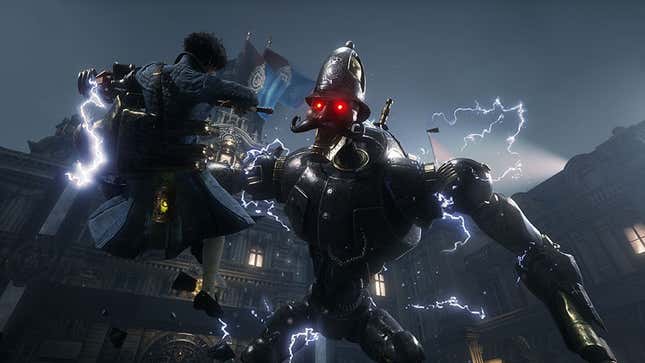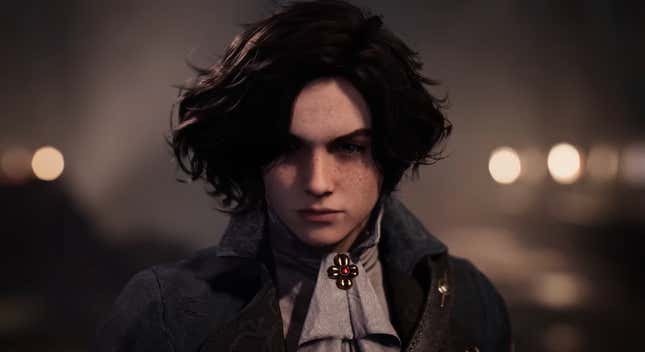
There have, at conservative estimate, been roughly a jillion games that have attempted to emulate the success of From Software’s Dark Souls—a task gaming companies typically undertake by building a credible version of Dark Souls’ slow-paced, meticulous combat, then unceremoniously dumping it into a video game world far more generic and uninspired than the vast, mysterious video game labyrinths the studio has built its reputation on.
It’s been far rarer for imitators to attempt to tackle From’s faster, grimmer 2015 masterpiece Bloodborne, though—to the point that, as far as we can tell, new South Korean action-adventure game Lies Of P might be the first full-throated Bloodborne clone to hit the market. Amazingly (and despite some rough first impressions), a full run through of Round8 Studios’ dark, violent reimagining of the Pinocchio story reveals that Lies Of P’s acts of mimicry are far more than mere mercenary gestures: This is clearly a game by, and for, people in love with not just Bloodborne’s quick-moving killing, but also its obsession with obscurity and mystery, and From’s carefully crafted design ethos as a whole.
Set in a be-steampunked Eastern European city called Krat, the game drops you into the springs and shoes of a character only ever referred to as “Geppetto’s puppet”—but who is, very clearly, what you’d get if a die-hard Timothée Chalamet fan decided to build themselves a Pinocchio. Beckoned by a blue butterfly (and accompanied, in one of the game’s less ingenious twists on Carlo Collodi’s original novel, by a chatterbox AI cricket named “Gemini”), the teen heartthrob puppet makes his way out into Krat, which finds itself ravaged by an uprising of its ubiquitous (and now quite murderous) automaton servants. Puppet murder, in serious abundance, ensues.
The fighting in Lies Of P is the game’s easiest early draw: slick, punishing, and with a healthy degree of customization that allows for expressive play to pop up with welcome regularity. That includes your generous arsenal of weapons, which can be assembled from a variety of handles and blades secreted around Krat, each of which have not only different stats and damage types, but, critically, move-sets. Struggling to reach a pesky boss that keeps dancing just out of the swings of your sword? Strap on a spear handle and poke with aplomb, or take an axe handle and get to making firewood. That kind of small-scale freedom is present in abundance here: Customizable buffs that let you specialize in inflicting different types of status effects; upgradeable “arms” that give you ranged options in heated battles; even a surprisingly robust perks system that sees you fit different bespoke upgrades into your, uh … P-Organ. (Look, we didn’t name it.)
As for the fighting itself, it is, as multiple people who put the game’s demo through its paces have noted, a hybrid of the quick-moving combat of Bloodborne with the more defensive (but no less fleet) fighting of From’s 2019 Sekiro—which is to say that there’s a heavy focus on timing your blocks and dodges, the better to create exploitable opportunities for a well-timed attack. Rank-and-file enemies will go down with fairly little trouble as you traverse the game’s (often very long, and linear) levels. But bosses will force you to fully grapple with the game’s defensive vocabulary. Is it better to try to time out a perfect guard on a big, telegraphed attack, or block and hope you can recover the damage that made its way through your shield? Roll through that combo, or pull back and wait for your foe to exhaust themselves? Score a few quick hits, or go for a slower, heavier strike that’s more likely to knock the opponent into a vulnerable “stagger” state? These are the questions running back-of-mind during each of Lies Of P’s major fights, and they’re no less compelling for taking place in a Pinocchio-based video game.

Those bosses do suggest that Round8 has picked up a few less savory habits from their heroes over in Dark Souls and Elden Ring land, though—most notably, a deep and insistent love affair with bosses who pull the old “Ha, not so fast” trick when it looks like you’ve beaten them. Especially in the back half of the game, it’s far easier to list those bosses that don’t get back up for a second round after you kill them the first time, typically with far more complex and devastating attacks added to their arsenal in the process. (If not simply a whole other boss fight, with an entirely different rhythm and move-set to learn.) It’s a trick that can be thrilling—every once in a while. As is, the otherwise strongly designed fights can often feel padded, even as you get better at whittling down the opening phases in less time so that you can get to the “real” challenge again. If we had to change a single thing about Lies Of P, it’d be those repetitive opening bouts.
Or maybe, again, that level design: Although Krat is lovely, it’s also a little, well, generic. Even as you’re winding your way through slums, factories, swamps, and more, the actual design rarely gets more complex than “hallway, big open room, hallway, ladder, hallway.” It’s the one place where P pointedly falls short of its (digital) source material: Bloodborne features one of the most horrifying and beautiful cities in all of gaming; Lies Of P features a series of corridors playing dress-up with the idea of a ravaged urban environment.
And yet, this is also the point where we feel moved to admit something: We were way too hard in our assessment of the game’s demo—especially as applied to its story. What fascinates about Lies Of P isn’t just its spin on the Pinocchio myth—although these spins are often genuinely clever, with imagery of puppet and puppeteer appearing in meaningful moments throughout the game, and a nigh-obsessive focus on the ways the human form can be twisted. No, the real victory here is the faithfulness with which Round8 recreates one of the most ineffable, but most important, aspects of the From Software template: The devotion to strange, obscure mysteries.

We’re not just talking about the obvious scavenger hunts the game sends you on, often granting you new costumes for the puppet. Krat is full of secrets—as is “P” himself, who begins exhibiting more human-like behavior as the game goes on, especially when you tell one of the titular Lies. (Which crop up regularly in conversational choices, a ticking clock imbuing each one with surprising weight.) The game does an excellent job of making all of this feel both meaningful and mysterious as hell: More than once, we stumbled into a strange moral choice, or a scenario where we probably could have avoided violence if we’d made other choices in the past, and came away emotionally affected. Round8 has also adopted the From trick of giving players just enough information to make credible guesses about large chunks of the game’s story, but rarely to confirm outright. By the time we reached one of what are reportedly multiple endings of the adventure, we had hit a mixture of confused and invested that was undeniably compelling—and which we normally only ever associate with Souls games, and never their imitators.
Lies Of P is, in other words a cover act—but the kind of cover act that only happens when a group of talented artists get together to pay homage to something they really, genuinely love. Playing it, we were caught, more than once, by the rare sensation of sharing an experience with someone who got why the Souls game work, rather than just slavishly aping the way they move or look. (This was, admittedly, often right after some truly heinous enemy ambush sent us tumbling off of a precarious ledge; game doesn’t fuck around with the difficulty.) At its worst, it’s a solid and credible copy of a gaming great. At its best—which is at least as often as not—it can hit many of the same highs. Despite an eventually exhausting length (we clocked out at 45 hours, and could probably have been happy at 35), it’s a satisfying experience in its own right, even if you’ve never played the games it takes as its (very obvious) inspiration.